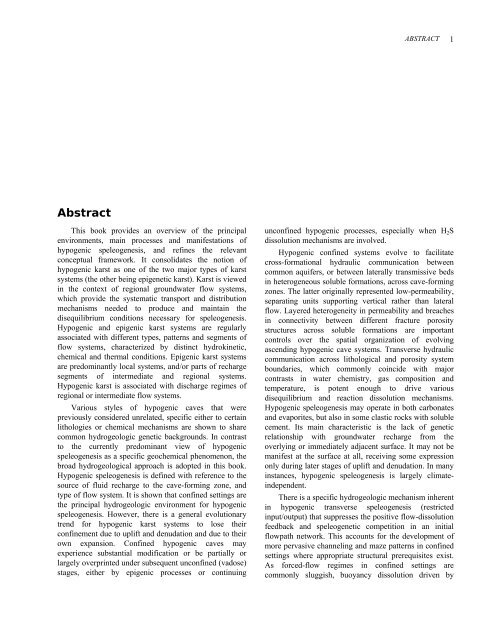Download PDF - Speleogenesis
Download PDF - Speleogenesis
Download PDF - Speleogenesis
Create successful ePaper yourself
Turn your PDF publications into a flip-book with our unique Google optimized e-Paper software.
Abstract<br />
This book provides an overview of the principal<br />
environments, main processes and manifestations of<br />
hypogenic speleogenesis, and refines the relevant<br />
conceptual framework. It consolidates the notion of<br />
hypogenic karst as one of the two major types of karst<br />
systems (the other being epigenetic karst). Karst is viewed<br />
in the context of regional groundwater flow systems,<br />
which provide the systematic transport and distribution<br />
mechanisms needed to produce and maintain the<br />
disequilibrium conditions necessary for speleogenesis.<br />
Hypogenic and epigenic karst systems are regularly<br />
associated with different types, patterns and segments of<br />
flow systems, characterized by distinct hydrokinetic,<br />
chemical and thermal conditions. Epigenic karst systems<br />
are predominantly local systems, and/or parts of recharge<br />
segments of intermediate and regional systems.<br />
Hypogenic karst is associated with discharge regimes of<br />
regional or intermediate flow systems.<br />
Various styles of hypogenic caves that were<br />
previously considered unrelated, specific either to certain<br />
lithologies or chemical mechanisms are shown to share<br />
common hydrogeologic genetic backgrounds. In contrast<br />
to the currently predominant view of hypogenic<br />
speleogenesis as a specific geochemical phenomenon, the<br />
broad hydrogeological approach is adopted in this book.<br />
Hypogenic speleogenesis is defined with reference to the<br />
source of fluid recharge to the cave-forming zone, and<br />
type of flow system. It is shown that confined settings are<br />
the principal hydrogeologic environment for hypogenic<br />
speleogenesis. However, there is a general evolutionary<br />
trend for hypogenic karst systems to lose their<br />
confinement due to uplift and denudation and due to their<br />
own expansion. Confined hypogenic caves may<br />
experience substantial modification or be partially or<br />
largely overprinted under subsequent unconfined (vadose)<br />
stages, either by epigenic processes or continuing<br />
ABSTRACT<br />
unconfined hypogenic processes, especially when H2S<br />
dissolution mechanisms are involved.<br />
Hypogenic confined systems evolve to facilitate<br />
cross-formational hydraulic communication between<br />
common aquifers, or between laterally transmissive beds<br />
in heterogeneous soluble formations, across cave-forming<br />
zones. The latter originally represented low-permeability,<br />
separating units supporting vertical rather than lateral<br />
flow. Layered heterogeneity in permeability and breaches<br />
in connectivity between different fracture porosity<br />
structures across soluble formations are important<br />
controls over the spatial organization of evolving<br />
ascending hypogenic cave systems. Transverse hydraulic<br />
communication across lithological and porosity system<br />
boundaries, which commonly coincide with major<br />
contrasts in water chemistry, gas composition and<br />
temperature, is potent enough to drive various<br />
disequilibrium and reaction dissolution mechanisms.<br />
Hypogenic speleogenesis may operate in both carbonates<br />
and evaporites, but also in some clastic rocks with soluble<br />
cement. Its main characteristic is the lack of genetic<br />
relationship with groundwater recharge from the<br />
overlying or immediately adjacent surface. It may not be<br />
manifest at the surface at all, receiving some expression<br />
only during later stages of uplift and denudation. In many<br />
instances, hypogenic speleogenesis is largely climateindependent.<br />
There is a specific hydrogeologic mechanism inherent<br />
in hypogenic transverse speleogenesis (restricted<br />
input/output) that suppresses the positive flow-dissolution<br />
feedback and speleogenetic competition in an initial<br />
flowpath network. This accounts for the development of<br />
more pervasive channeling and maze patterns in confined<br />
settings where appropriate structural prerequisites exist.<br />
As forced-flow regimes in confined settings are<br />
commonly sluggish, buoyancy dissolution driven by<br />
1
















